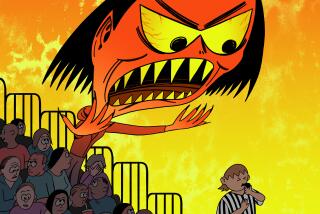Teen athletes need to take extra care
- Share via
Now that summer break is over and the little monsters -- er, darlings -- are back where they ought to be, make sure you keep an eye on their training for fall sports. The last thing you want is to have them injured and lounging on the couch they just left. Unfortunately, if your kids are loungers, the risk of injury is higher than for student athletes who stayed active during vacation or had a well-structured preseason (preferably both). The best prevention from the tweaks and tears that can bedevil soccer, football, cross-country and other fall athletes is for them to be in shape before they hit the field.
Regardless of where kids start, sports medicine pros have a few suggestions to keep them injury-free.
Let’s begin with the boys.
My son Jack is a senior in high school, and about the last thing I would have worried about during football training are his “growth plates” -- the soft bone ends in children that let the bone expand until it gradually hardens in adolescence. He’s taller than I am, can best me on a couple of strength tests, and I would think he is close to being done with his growing.
But I don’t know that for sure. Particularly for boys, it is possible for the bone ends to remain soft and open to more growth later than you might expect.
Craig Miller, an orthopedic surgeon and sports medicine specialist at Shady Grove Orthopaedic Associates in Rockville, Md., says that any swollen joint in a teenager should be treated as a warning sign. The type of ankle or knee sprains that adults can ice and wait out might signal injury to a bone that isn’t finished developing -- and is at risk of stunted growth or deformity if it is put under further stress.
If the swelling does not go away in a day or two, see a doctor, and make sure the exam includes the possibility of growth plate damage. (It may take an MRI or X-ray of the non-injured side of the body to tell if the bone is still soft.)
“If a child is complaining of an injury or if they are limping, if there is a swollen joint, that is something that should not be ignored,” Miller said. “A swollen joint in a child is a very big deal.”
For girls playing soccer, basketball or any sport with a lot of lateral motion, knee injuries -- and specifically, injuries to the anterior cruciate ligament, known as ACL -- have become a mini-epidemic, occurring at four to six times the rate for male high school athletes.
Researchers now think they know the cause: Female athletes tend to have strength imbalances between their quadriceps and their hamstrings, and also tend to be more stiff-legged in their running and jumping.
That combination is disastrous for the ACL, which connects the thigh and shin bones, said Perry Esterson, a physical therapist and sports specialist at Physiotherapy Associates in Fairfax, Va. If the athlete is changing direction or landing from a jump, the quadriceps puts pressure on the ligament; without adequate strength in the hamstring to counteract it, the chance of a tear increases.
If your daughter is a soccer, basketball or lacrosse player, consider one of the special “jump training” programs developed to lower the risk of ACL tears among women -- or, better yet, see if her school or league is willing to adopt one.
The Cincinnati SportsMedicine Research and Education Foundation, for example, has developed a six-week sequence to teach women who are not naturally “soft” jumpers how to change their landings so the force is better distributed.
Frank Noyes, president of the foundation, offers a simple test for any concerned parent: Play hopscotch and watch what happens. If your child wobbles on a one-foot landing, or if the leg is straight when she comes down, she is pressuring the ACL.
“If you land with a straight knee, that is dangerous. . . . If you have the knee joint anywhere away from the rest of the body . . . it is going to produce an imbalance,” Noyes said. Finally, a no-brainer: hydration. Dehydration during a workout can lead to cramps, headaches and dizziness tied to heat exhaustion, or even heat stroke.
If you are in doubt about what’s happening, put kids on the scale. If they weigh in at 150 in the morning and are down to 148 after practice, they will need to knock down about two pints of water over the rest of the day -- roughly a pint per pound. (As teenagers they may not want to talk about this, but let them know that if they are properly hydrated their urine will be on the clear side. If it’s dark yellow, they need to drink more.)
Yeah, all this precaution and injury-prevention stuff can be a drag. But it’s a whole lot better than surgery or weeks of therapy, not to mention better than having them home on the couch.
More to Read
Go beyond the scoreboard
Get the latest on L.A.'s teams in the daily Sports Report newsletter.
You may occasionally receive promotional content from the Los Angeles Times.










